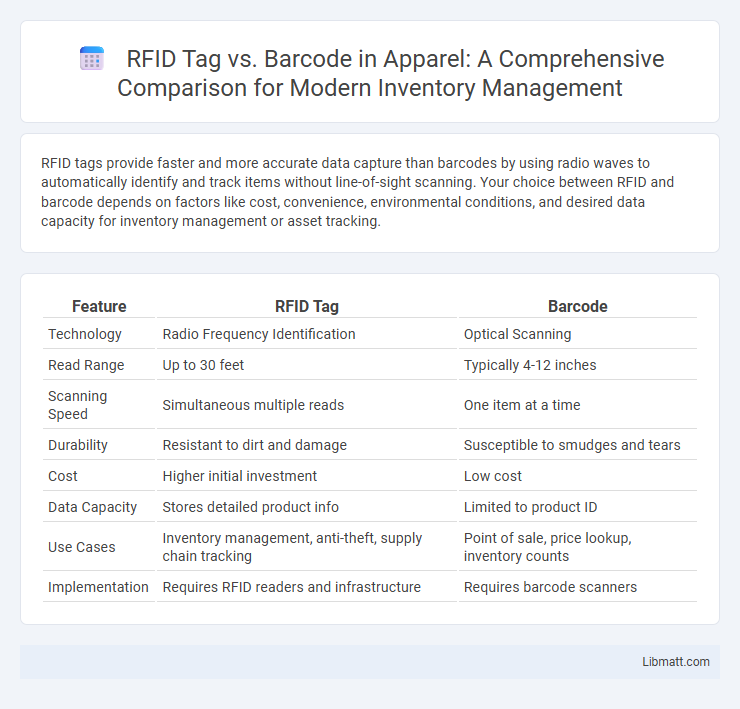RFID tags provide faster and more accurate data capture than barcodes by using radio waves to automatically identify and track items without line-of-sight scanning. Your choice between RFID and barcode depends on factors like cost, convenience, environmental conditions, and desired data capacity for inventory management or asset tracking.
Table of Comparison
| Feature | RFID Tag | Barcode |
|---|---|---|
| Technology | Radio Frequency Identification | Optical Scanning |
| Read Range | Up to 30 feet | Typically 4-12 inches |
| Scanning Speed | Simultaneous multiple reads | One item at a time |
| Durability | Resistant to dirt and damage | Susceptible to smudges and tears |
| Cost | Higher initial investment | Low cost |
| Data Capacity | Stores detailed product info | Limited to product ID |
| Use Cases | Inventory management, anti-theft, supply chain tracking | Point of sale, price lookup, inventory counts |
| Implementation | Requires RFID readers and infrastructure | Requires barcode scanners |
Introduction to RFID Tags and Barcodes
RFID tags use radio waves to automatically identify and track objects, offering contactless scanning and real-time data updates, while barcodes rely on optical scanning requiring line-of-sight for reading. RFID technology enhances inventory accuracy and speeds up processes compared to traditional barcode systems. Your choice between RFID tags and barcodes impacts operational efficiency, data management, and overall supply chain visibility.
How RFID Tags Work
RFID tags use radio waves to automatically identify and track objects by transmitting data to a reader without requiring line-of-sight scanning, unlike barcodes which need direct visibility. The RFID system includes a reader, antenna, and a tag with a microchip that stores unique information, allowing for quick and accurate scanning even through materials like plastic or cardboard. This technology enables faster inventory management, real-time asset tracking, and reduced human error in comparison to traditional barcode systems.
How Barcodes Function
Barcodes function by encoding data in a visual pattern of parallel lines or spaces that a scanner reads using light reflection to interpret the information. The scanner converts the reflected light into electrical signals, which are then decoded into readable data by a computer system. Unlike RFID tags, barcodes require a direct line of sight for scanning and are limited to storing relatively small amounts of data.
Key Differences Between RFID and Barcodes
RFID tags use radio waves to transmit data wirelessly, while barcodes rely on optical scanning to read visual patterns. RFID allows for faster, bulk scanning without direct line-of-sight, improving inventory accuracy and efficiency compared to barcodes, which require individual scanning. Your choice between RFID and barcodes depends on factors like cost, read range, and environmental conditions affecting data capture.
Advantages of RFID Tags
RFID tags offer superior data capacity and faster scanning speeds compared to barcodes, enabling real-time inventory tracking and improved supply chain management. Unlike barcodes, RFID tags do not require line-of-sight scanning, allowing multiple items to be read simultaneously and reducing human error. Enhanced durability and resistance to environmental factors make RFID tags ideal for diverse industrial applications.
Benefits of Barcode Technology
Barcode technology offers cost-effective and easy implementation with widespread compatibility across various industries, providing quick and accurate data capture for inventory management and point-of-sale systems. It enables efficient product tracking and reduces human error through automated scanning, enhancing operational productivity. Barcode systems require less maintenance and have a proven track record of reliability in retail, logistics, and healthcare sectors.
Limitations of RFID vs. Barcode Systems
RFID tags face limitations such as higher costs and potential interference from metal or liquids, which can affect reading accuracy and range. Barcodes require direct line-of-sight scanning and are susceptible to damage or dirt compromising readability, but they remain more cost-effective for many applications. Understanding these trade-offs will help you determine the best system for your inventory or tracking needs based on environment and budget constraints.
Cost Comparison: RFID vs. Barcode
RFID tags typically incur higher initial costs ranging from $0.10 to $0.50 per tag compared to barcode labels, which average between $0.01 and $0.10 each. Despite the upfront expense, RFID systems reduce labor and inventory errors, resulting in lower long-term operational costs. Barcode technology remains cost-effective for low-volume or budget-conscious projects but lacks RFID's advantages in speed and bulk scanning capabilities.
Applications in Industry and Supply Chain
RFID tags enable real-time inventory tracking and asset management in industries, offering greater accuracy and speed compared to barcodes, which require line-of-sight scanning. In supply chain operations, RFID improves visibility through automated data capture and reduces human errors, enhancing shipment accuracy and reducing losses. Your business benefits from RFID's ability to streamline processes and provide detailed insights, especially in complex logistics and large-scale manufacturing environments.
Which Technology Is Best for Your Business?
RFID tags offer faster data capture and greater durability compared to barcodes, making them ideal for businesses with high-volume inventory or complex supply chains. Barcodes provide a cost-effective solution for small to medium-sized operations with straightforward scanning needs and limited exposure to harsh environments. Selecting the best technology depends on factors such as budget, inventory size, read range requirements, and environmental conditions specific to your business.
RFID Tag vs Barcode Infographic

 libmatt.com
libmatt.com